175 Search Results for gail van tatenhove
July 22, 2013
by Robin Parker -
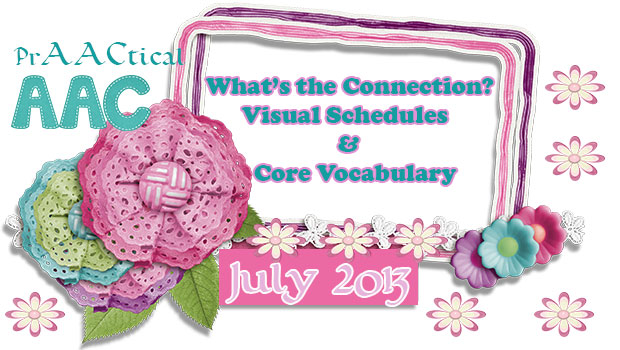
Because it seems there has been a lot of emphasis on core words and visual schedules over the past couple of months, we wanted to highlight a particular resource titled: Visual Schedules to Expose & Reinforce Core Vocabulary by (the great) Gail Van Tatenhove. This resource can be found on the Minspeak website which shares excellent (& free) comprehensive AAC information for everyone. You can search by categories and get fact sheets, communication boards, curriculum supports and more. AAC users, families, & caregivers Teachers and therapists Academicians & students Teaching Plans & Materials Pixon Project Resources Try out some of the ideas from the Visual Schedule/Core Word Resource or something else and let us know what you think.
May 27, 2013
by Carole Zangari -

Ask any 10 professionals how they do AAC evaluations and you’re likely to get 10 different answers. We look for the same things (I think!) but go about it in different ways. We’re always happy to take a look at the protocols and forms that our colleagues develop and/or use. Here are some that might be of interest. 1. Bloom and Lahey Recording Sheet for staging language by Sherri Vernelso and Emily Pratt 2. Kate Ahern’s form for AAC device trials 3. SETT process assessment forms by HILIA Coordinators of Assistive Technology Services 4. The Functional Behavior Assessment Worksheet and Observation Forms by PaTTAN 5. Assessing the metaphoric use of pictures (e.g., Minspeak, Unity) protocol and forms by Gail Van Tatenhove If you have a protocol or form that you’d like to share, please get in touch. We’re always looking for new and better tools.
May 19, 2013
by Robin Parker -
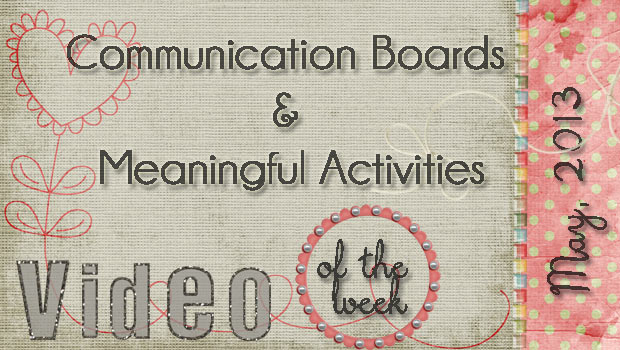
Gail Van Tatenhove expertly demonstrates teaching with a Pixon communication board. In this video, she introduces the communication board and implements a variety of best practice AAC teaching strategies. Can you spot them?
April 29, 2013
by Carole Zangari -
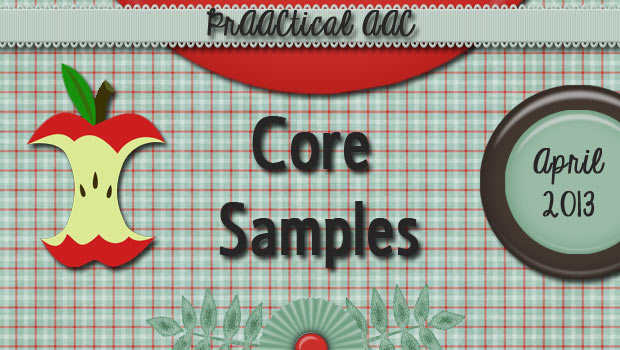
Whether we’re working on a project, cooking with new ingredients, or doing something crafty, one of the things we find most helpful is examples. Seeing how other people have approached a situation can be informative and inspiring. Making communication displays for people who use AAC is no different. Most of us appreciate the opportunity to see what our colleagues have done. We provided a number of examples of communication boards and books that are rich in core language in some of our earlier posts. Here are some of them, just in case you missed those posts. Kate Ahern’s Core Vocabulary in 3 Symbol Types (and Core Word Learning Book) via SlideShare Core language board with 20 PCS and 12 PCS by Yvonne Green via SET-BC PCS communication book (core and fringe) from the AT4All Wiki/Barbara Cannon PCS communication book pages in Boardmaker and PDF format by Polk County Public Schools... [Read More...]
April 26, 2013
by Carole Zangari -
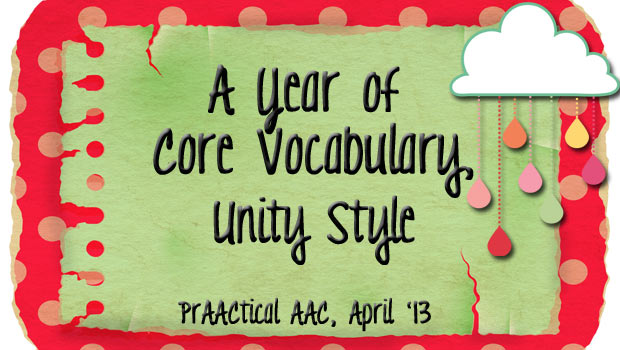
One of the things we most appreciate about the AAC community is the generosity of spirit and sense of collaboration. When we first posted our Year of AAC Core Vocabulary, Gail Van Tatenhove, Russell Cross, and others in the Minspeak community generously shared it with professionals and families. More importantly, they adapted it with Minspeak symbols so that the resource could be more useful to people learning to communicate with that symbol system. We’re excited to be able to share the Year Of AAC Core adapted by Russell Cross. There are two versions: one for people learning 84-location Unity programs and another for people working with the 144-location version. There is one set of cards for each month with about 12 core words each so that professionals can provide extra practice of a selected set of core words. Many, many thanks to Gail and Russell for adapting our work and... [Read More...]
April 20, 2013
by Carole Zangari -
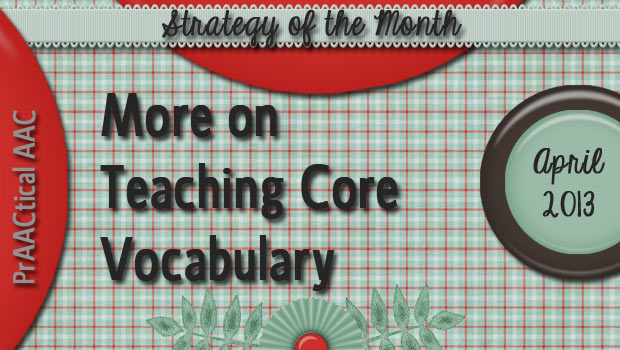
Last week, we talked about two key strategies for teaching core language: using aided language input and creating frequent opportunities to teach and elicit core words. In today’s post, we’ll expand the number of words and discuss two additional considerations for teaching core words. Aided language input is always important in working with beginning users of AAC. It exposes them to their new means of communication, provides them with a competent model of their AAC system, and introduces them to words and symbols they don’t yet know within a meaningful context. It also forces us to slow down when talking, something that can be very beneficial when you consider that many beginning users of AAC also have difficulty processing oral language. (It may take them longer to decode what they’re hearing and they may have to concentrate more than the average kid.) If you’ve actually tried pointing to symbols as... [Read More...]
March 29, 2013
by Carole Zangari -
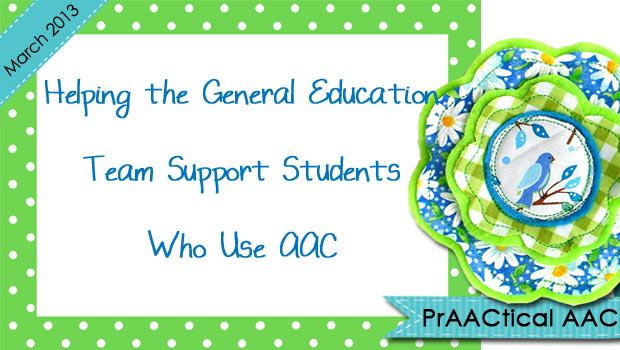
In the past few months, we’ve shared some articles on AAC in general education. We’ve looked at the development of an AAC intervention plan that relates to curriculum standards and using math and science standards as a context for building AAC skills. In this post, I’d like to share my own contribution to that issue of ASHA’s Special Interest Group (SIG) quarterly publication, Perspectives on AAC. Although the final versions are available only to SIG members, clearance has been given to post the original articles. As we all know, AAC skills are best learned when the entire team is headed in the same direction, using robust instructional methods, and communicating well with one another. In this article, I discuss some of the ways that we can clarify the expectations of each team member so that all the bases are covered and our individual efforts complement one another. Thoughts on managing assessment... [Read More...]
February 22, 2013
by Carole Zangari -
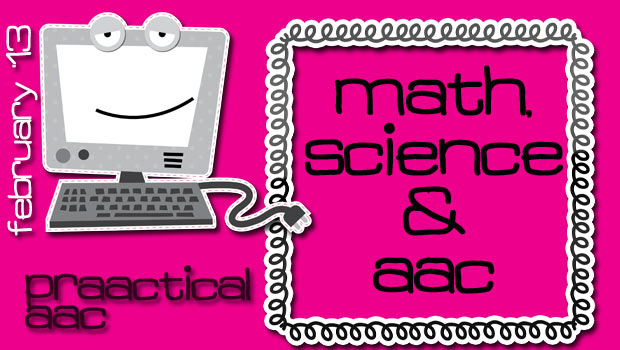
In an earlier post, we began sharing content on AAC and inclusion based on articles from ASHA’s Special Interest Group (SIG) quarterly publication, Perspectives on AAC. Although the final versions are available only to SIG members, clearance has been given to post the original articles. Today, we are pleased to share the work of Michele Boruta and Kara Bidstrup. In this article, they discuss a process for using standards‐based math and science curricula to build the linguistic competence of students who use AAC. In the US, there is an increasing focus on using the curriculum as the launching point for all IEP-driven intervention. Though the mandate for using curricula as the context for therapies is not new, many SLPs are still getting comfortable with this approach. We hope this article provides some prAACtical guidance for therapists who are striving to integrate AAC teaching with curriculum content. Thank you to Ms.... [Read More...]
January 25, 2013
by Carole Zangari -

Many of our prAACtical AAC friends are members of ASHA’s Special Interest Group (SIG) on AAC and are able to access their quarterly publication, Perspectives on AAC. I was fortunate to be invited to submit an article for the September 2012 edition, guest edited by Gail Van Tatenhove, on the topic of including students with robust AAC devices in general education classrooms. Access to the final publication is limited to those who are ASHA SIG members, but Gail did get clearance for authors to be able to share their original unedited works. Several of those authors have given permission for their articles to be published on the Minspeak website and also here on our site. In this post, we would like to share the work of Solana Henneberry, Jennifer Kelso, and Gloria Soto. This article describes a process of developing an AAC intervention plan that relate to the Common Core... [Read More...]
January 7, 2013
by Carole Zangari -
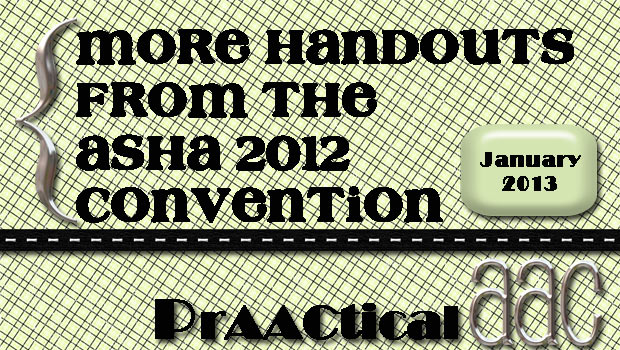
Getting to conferences to hear about new developments in AAC is always re-energizing. Here are some of the handouts from ASHA’s 2012 Convention in Atlanta. Edwin and Esther Prentke AAC Distinguished Lecture: Education, Empowerment, and Employment of People Who Use AAC by Jennifer Lowe Using AAC Device-Generated Data to Develop Therapy Sessions by Russell Cross Analyzing Language Development Physically Impaired Children Using AAC Devices by Moniks Ortloff, Paul Andres, Meher Banajee, and Gail Van Tatenhove Teaching Children to Produce Novel Multi-Symbol Questions/Statements via AAC Apps by Jennifer Kent-Walsh, Cathy Binger, Pamela Resnick, and Carolyn Buchanan The App Revolution: Where Are We in the Evolution? by Elizabeth (Libby) Rush and Celeste Helling









